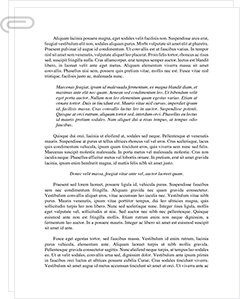 Study Document
Study Document
Crafted Cheese Generally Accepted Accounting Term Paper
Pages:3 (922 words)
Sources:1+
Subject:Business
Topic:Certified Public Accountant
Document Type:Term Paper
Document:#24658933
The balance sheet includes two main categories, assets and liabilities and shareholders' equity. Both of these are in turn split into current assets and other assets. In terms of current assets, all three companies include inventory, cash and cash equivalents and receivables, while the liabilities cover short- and long-term debt, as well as the shareholders' equity.
The cash flow statement includes the three different categories, cash flows from operating activities, cash flows from investing activities and cash flows from financing activities.
In order to be able to properly evaluate, we need to mention that the net income "measures business revenues vs. expenses." In this sense, the income statement provides the best expression and explanations on how the business is actually performing, what could or should be improved.
On the other hand, the net cash from operating activities simply records how much money is received from customers, other firms, etc. In this sense, the two notions are similar to the accrual vs. accounting dilemma, with a strong recommendation for the former, as a better indicator of the overall health of the company.
In terms of prediction, its is quite difficult to make evaluations without calculating fundamental financial ratios that determine whether the company has a healthy short-term solvability (current ratio) or the overall profitability of the company (return on investment). On the other hand, the three companies seem to be performing well, with strong spending on the research and development side, a trend which is also proven by some of the chairmen's declarations in the annual report.
Bibliography
1. Financial Statements - an introduction. College of Business and Economics. Western Washington University. On the Internet at http://www.cbe.wwu.edu/SBDC/resources/articledetail.asp?RecordID=10
2. What are Generally Accepted Accounting Principles?. On the Internet at http://www.allbusiness.com/articles/content/17954.asp
3. Trading Glossary. On the Internet at http://www.trading-glossary.com/h0056.asp
4. Klinefelter, Danny; McCorkle, Dean (2003). Financial Management: Cash vs. Accrual Accounting. Agricultural Communications, the Texas a&M University System. On the Internet at http://trmep.tamu.edu/cg/factsheets/rm5-16.html
http://ir.exxonmobil.com/phoenix.zhtml?c=115024&p=irol-irhome
6. http://www.ford.com/en/company/investorInformation/companyReports/annualReports/default.htm
http://www.microsoft.com/msft/ar.mspx
What are Generally Accepted Accounting Principles?. On the Internet at http://www.allbusiness.com/articles/content/17954.asp
Trading Glossary. On the Internet at http://www.trading-glossary.com/h0056.asp
Klinefelter, Danny; McCorkle, Dean (2003). Financial Management: Cash vs. Accrual Accounting. Agricultural Communications, the Texas a&M University System. On the Internet at http://trmep.tamu.edu/cg/factsheets/rm5-16.html
Financial Statements - an introduction. College of Business and Economics. Western Washington University. On the Internet at http://www.cbe.wwu.edu/SBDC/resources/articledetail.asp?RecordID=10
Sample Source(s) Used
Bibliography
1. Financial Statements - an introduction. College of Business and Economics. Western Washington University. On the Internet at http://www.cbe.wwu.edu/SBDC/resources/articledetail.asp?RecordID=10
2. What are Generally Accepted Accounting Principles?. On the Internet at http://www.allbusiness.com/articles/content/17954.asp
3. Trading Glossary. On the Internet at http://www.trading-glossary.com/h0056.asp
4. Klinefelter, Danny; McCorkle, Dean (2003). Financial Management: Cash vs. Accrual Accounting. Agricultural Communications, the Texas a&M University System. On the Internet at http://trmep.tamu.edu/cg/factsheets/rm5-16.html

